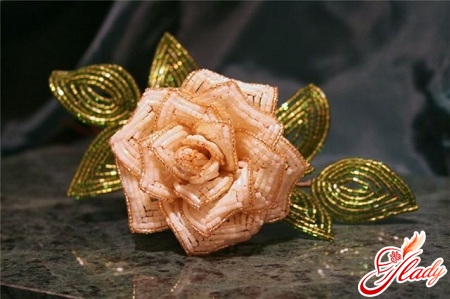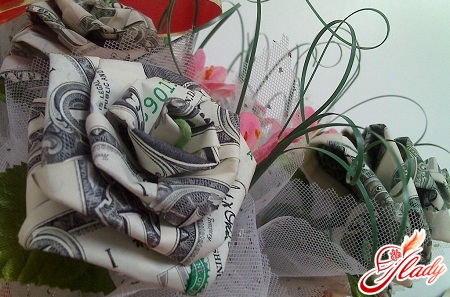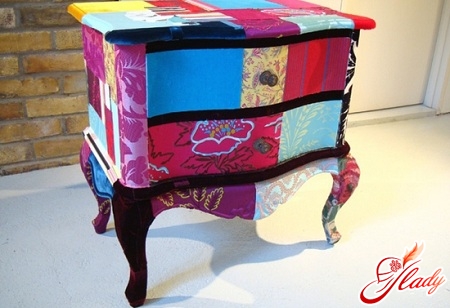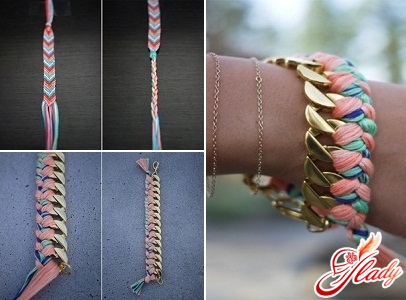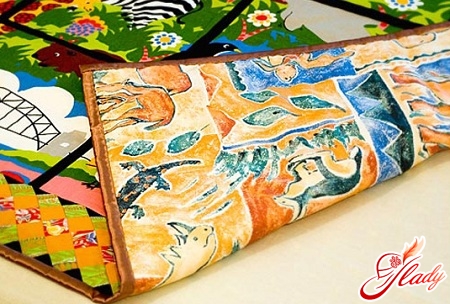 If in the childhood you were fond of collecting mosaics,then you must understand how exciting this process is. By the way, adults do not lose their excitement and desire to create unpredictable bizarre patterns, correct ornaments or completely recognizable images of objects from scattered pieces. And they realize this aspiration with the help of equally fascinating needlework, called patchwork sewing, creating with their own hands everything that can be made with the help of takna, thread and needle. It can be a stylized patchwork quilt, a quilted blanket or potholes for the kitchen, and clothes for adults and children, and decorative panels. And let the patchwork sewing initially had utilitarian tasks. Today, scraps are sewn into whole canvases not for reasons of economy, but rather from the desire to create beauty and to enjoy this truly magical action. The sewing of patchwork is known to almost everyone. Wherever people worked with textiles, it existed in one form or another. Today, combining the experience of different countries, fans of patchwork sewing call themselves quilters, create clubs for interests, organize festivals. They improve the well-known old techniques, invent new ones and create with their own hands unusually spectacular patches, which sometimes can not be called a product - it's just works of art. By the way, speaking of works of art, we do not sin against the truth, because for patchwork - patchwork sewing there is quite an official definition of "kind of decorative and applied art." And how many species of this species! Yes, and the techniques themselves working with the rags of fabrics are an unthinkable amount. Let's get acquainted with at least some of them, and at the same time find out what are the fundamentals of patchwork sewing.
If in the childhood you were fond of collecting mosaics,then you must understand how exciting this process is. By the way, adults do not lose their excitement and desire to create unpredictable bizarre patterns, correct ornaments or completely recognizable images of objects from scattered pieces. And they realize this aspiration with the help of equally fascinating needlework, called patchwork sewing, creating with their own hands everything that can be made with the help of takna, thread and needle. It can be a stylized patchwork quilt, a quilted blanket or potholes for the kitchen, and clothes for adults and children, and decorative panels. And let the patchwork sewing initially had utilitarian tasks. Today, scraps are sewn into whole canvases not for reasons of economy, but rather from the desire to create beauty and to enjoy this truly magical action. The sewing of patchwork is known to almost everyone. Wherever people worked with textiles, it existed in one form or another. Today, combining the experience of different countries, fans of patchwork sewing call themselves quilters, create clubs for interests, organize festivals. They improve the well-known old techniques, invent new ones and create with their own hands unusually spectacular patches, which sometimes can not be called a product - it's just works of art. By the way, speaking of works of art, we do not sin against the truth, because for patchwork - patchwork sewing there is quite an official definition of "kind of decorative and applied art." And how many species of this species! Yes, and the techniques themselves working with the rags of fabrics are an unthinkable amount. Let's get acquainted with at least some of them, and at the same time find out what are the fundamentals of patchwork sewing.
The Ace of Patchwork Technology
At first glance, nothing complicated in this formThere is no needlework: pick up pieces, sew them into whole canvases and get ready-made products. Well, in some ways this opinion is correct. Technology is not really complicated. But only to realize this is not so simple. The technique of patchwork embroidery includes three main stages.
This needlework, in addition to materials (fabrics and threads) requires a certain set of tools
- scissors or special roller knife;
- sewing needles and pins;
- chalk or a pencil for drawing a picture on a fabric;
- paper, cardboard or soft plastic for patterns;
- sewing machine or crochet hook.
Quite uncomplicated set, which, by the way,can be purchased in finished form (except for the sewing machine) in special shops for needlework. Typically, such sets include patterns. These tools, together with the materials will allow you to work in any kind of patchwork and make simple and complex products made in any of its techniques. 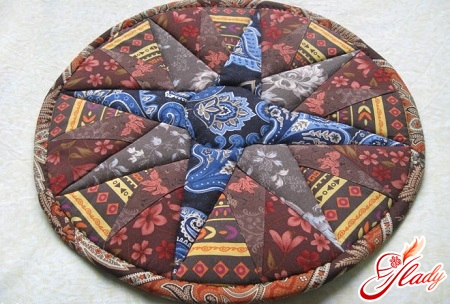
Types of quilting
Quilting is a rather extensive concept. This modern needlework is represented by various kinds and techniques. Here are some (most popular) types of patchwork.
- Traditional patchwork
Anglo-American needlework, the purpose of which -the creation of a single canvas of individual scraps folded into geometric patterns. In this technique, you can sew and a large blanket, and small potholders for the kitchen. Typically, the sewn coverlet or smaller items have a front (patchwork) side and a lining.
- Crazy patchwork (crazy shred)
A patchwork variation that respectstechnology of making patchwork cloths using arbitrary (irregular) figures, curves of strips and applications. In addition, the seams are masked with braid or embroidery, and the product itself (blanket, pillow, panel, bag, clothes) is abundantly decorated with ribbons, beads, lace and other accessories.
- Knitted patchwork
Another version of the traditional patchwork,where a somewhat different technology of connecting flaps is used. Here, individual fragments are attached to each other with a contrasting thread and a crochet hook.
- Japanese patchwork
The technology of patchwork sewing, combiningeastern and western traditions. It actively uses stitch, and preference is given to silk fabrics, from which you can make both a chic quilt, and panels, and clothing. The patterns are based on traditional geometric shapes: squares, triangles, diamonds, corners.
- Quilting
It is believed that quilting is a widerconcept than patchwork. However, in literal translation, "quilting" is a quilted cloth. This is the technology of creating patterns with stitches, when a soft padding made of sintepon, cotton wool or batting is laid between two canvases, and the pattern is embroidered with a machine stitch. The voluminous blanket or quilt created in the quilting technique looks more elegant than just collected from the flaps. With equal success it is possible to use this technique also in the manufacture of tacks for the kitchen, sofa cushions or clothes for children. 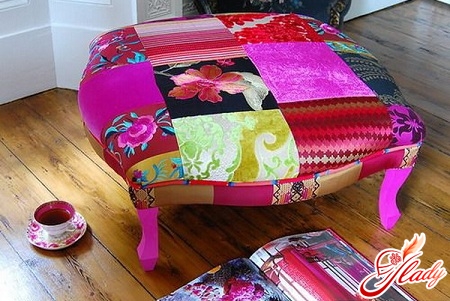
Techniques of quilting
The technology of sewing flaps at first glanceis simple enough: cut and sew, creating with your own hands any conceived product: a blanket, a tablecloth, a pillow, pothooks for the kitchen or naughty clothes for children. But this is only at first glance. Patchwork - needlework, requiring only the ability to handle a needle and thread, but also artistic taste, diligence, assiduity and accuracy. If you look at the samples of products, then there is only one question. How exactly can you create such different patterns using the same elements: blocks of strips or individual bands, squares, angles and triangles, rhombuses? And it's all about different techniques, with which the most incredible patterns are created. Let's look at some of the most popular techniques (methods) of patchwork sewing.
- Technique "Quick squares"
Very convenient technique for beginners. In this way, prefabricated square blocks (fast squares) are made, cut from pre-sewn strips of fabric. In this technique, you can make a large blanket in a matter of hours.
- Technique "Watercolor"
A fairly popular technique, in which toosquares are used. Sometimes squares are stitched into blocks from which the canvas is made. The main condition of a successful product is a correctly chosen color scheme.
- Technique «Strip to strip»
Patchwork sewing using multi-coloredstrips of fabric. Collecting a picture of the bands, their location and combination can be varied as you like. It is so easy to sew a mischievous rug or a large patchwork cover in the form of laid parquet boards: a ladder, a zigzag, rhombuses or corners. As a result of the stripes receive patterns "Parquet", "Arable land", "Christmas tree" and "Well."
- The technique of "Log Hut"
Another way to sew from strips. In this technique, the strips are gathered around a central square, laying them in a spiral. One of the variants of this technique is the displacement of a square into an angle. And for the clarity of the pattern, the pattern is collected from paired, one-color stripes.
- The technique of "Magic Triangles"
Triangles are one of the most commonelements in patchwork sewing. Not only that this figure was attributed to magical power, triangles are also very convenient to work with. Of these, make up both simple squares and complex stars. Most often in patchwork embroidery use rectangular isosceles triangles. Sewing them on the long side, get two-colored squares, and connecting the short sides - patterns from multi-colored motley stripes. The most popular patterns, in which triangles are applied: "Mill", "Diamond", "Star".
- Technique «Patchwork corners»
Russian invention. The technique differs from all previous ones in that the corners are not cut out according to the pattern, but are made up of squares or stripes of fabric. Then the resulting corners are gathered into strips (braid) from which the canvas is sewn. With this technique of patchwork, a three-dimensional cloth is obtained.
- Shakhmatka technique
Squares are also used here, or rather notsquares, and squares, which are stacked in checkerboard order. By the way, you can collect a chessboard from rhombuses, simply by unfolding the squares with an angle. There is a pattern from the elements of two contrasting colors.
- Technique «Russian square»
National Russian technology, differentthe complexity of the assembly of the pattern, which is based on the square, and the upper and lower tiers are made up of isosceles triangles. The following tiers of the pattern are collected from strips and triangles. Tiers make either the same in size, or "growing" from the center to the edges.
- The Sota technique
It is also known under the name "Grandma's Garden". The canvas is made of hexagons and resembles honeycombs. Sometimes a flower is gathered from hexagons, the middle of which is highlighted by a button, covered with a cloth.
- The technique of "Lapachikha"
Very peculiar and mischievous way of patchworksewing, which results in a three-dimensional fabric. In this technique, untreated color strips of fabric (lapaka) are threaded onto the substrate. This, by the way, is also a national Russian invention. In the imported version, a similar technique is known as "yo-yo." Talking about the techniques of patchwork sewing can be endlessly - how many patterns can be made from different figures, so much and the technique exists in patchwork sewing. Therefore, let us dwell on what we have already considered, and in conclusion we will talk about the ideas of using species and techniques of patchwork sewing.
The ideas of quilting
With your own hands with the help of multicolored patchescan create truly masterpiece. Ideas for work can be scooped from the air. Look around: what would you like to change in your house? Traditional or knitted patchwork is a great way to update interior textiles: blankets and bedspreads for beds, covers and covers for sofas and armchairs, tablecloths, rugs, kitchen potholders and towels can all be sewn by hand. Your clothes and accessories to it are also an inexhaustible source of inspiration. From the flaps you can make any items of the wardrobe (except for shoes). For example, an autumn jacket, for work with which it is better to use the ideas and techniques of quilting or Japanese patchwork. From the canvas, you can get elegant skirts or blouses, colorful vests that will dilute the severity of an office suit. And how many nice things you can sew with your own hands for children, also taking the basis of patchwork technique! And besides clothes there are opportunities for patchwork sewing: bags and cosmetic bags, wallets and cases, cases for phones. In short, everything you can sew yourself, you can sew from the flaps. There would be a desire, the skill of working with a cloth, the ability to scribble on a typewriter. And, of course, diligence, perseverance and enthusiasm. After all, only an enthusiastic person is able to be almost a magician. Is not this magic? A shred to the rag, a stitch to the stitch - and here is a miracle before us. Learn to be a sorceress! We advise you to read:




